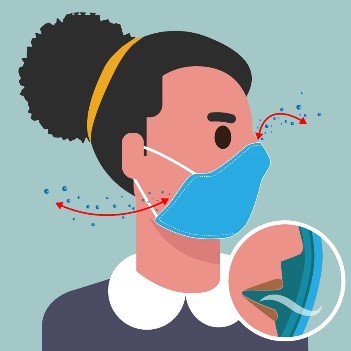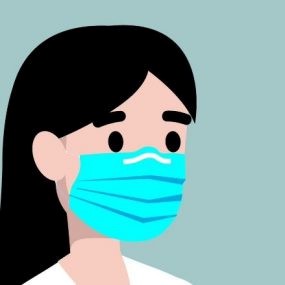BackgroundAll Californians should continue using available
tools, including masks, to help mitigate the spread of COVID-19 and other respiratory infections in their community. Wearing a mask consistently and correctly is one of the best ways to protect yourself from getting COVID-19 or other respiratory infections.
Masks remain a critical component for protecting the most vulnerable people in our communities, including older adults, people who are
immunocompromised, have certain disabilities or
underlying health conditions, and are otherwise at increased
risk of getting severe COVID-19 and other respiratory infections.
Masks vs. Respirators
Throughout this and other guidance, the term “mask" is used to refer to both loosely fitting cloth and surgical masks and tightly fitting respirators.
Respirators are a specific category of masks that are designed so that every time users breathe in or out, each breath is filtered through the material. Respirators provide the best protection against airborne diseases, including COVID-19.
When Masks Should be Worn
The California Department of Public Health (CDPH) recommends all Californians wear a mask:
- Around others if you have respiratory symptoms (e.g., cough, runny nose, and/or sore throat),
- If you've had a significant exposure to someone who has tested positive for COVID-19, wear a mask for 10 days.
- If you test postive for COVID-19, see guidance for mask wearing in the CDPH
Guidance for Isolation and Quarantine of the General Public.
In addition, wearing a mask is increasingly important for those who are
at higher risk for getting very sick from COVID-19, and as the risk for transmission increases in the community. Examples of settings where it may be important to wear a mask:
-
In indoor public settings where people who are older or have medical conditions that put them at higher risk of severe illness may reside or are cared for (such as hospitals, skilled nursing facilities, and long term-care facilities).
- In crowded indoor public settings that may have poor ventilation, including public transportation and other congregate settings.
- See
additional information on how to assess your risk in indoor public settings and
exposure risks.
Even when you're at home, there are times when a higher level of protection is important, such as when:
- You are providing care for someone who is sick with or who may have been exposed to someone with COVID-19 or another respiratory infection.
- You live in a household with someone who is suspected of having or has COVID-19 or another respiratory infection.
Local health jurisdictions and other entities may continue to have requirements in specific settings based on local circumstances, including in certain higher-risk settings or during certain situations that may necessitate mask requirements (for example, during active outbreaks in high-risk settings).
Furthermore, no person can be prevented from wearing a mask as a condition of participation in an activity or entry into a venue or business (including schools or childcare) unless wearing a mask would pose a safety hazard.
Characteristics of a Good Mask
An effective mask has both
good fit and
good filtration.
Gaps between the face and mask, such as above the nose or at the sides, allow air carrying virus particles to easily leak in or out without being filtered.
Facial hair (PDF) can also interfere with a good fit. Even a gap smaller than the size of a dime will allow the majority of air to bypass the filter, significantly reducing the effectiveness of any mask.
Generally, masks that have head loops (rather than ear loops) have better fit, forcing the air that you breathe in and out to go through the mask and be filtered. No matter what kind of mask you wear, check the fit and try to eliminate gaps above the nose or on the sides.
See additional information about non-US respirator models. The best mask has a high-quality filter, has a good fit against your face, and is comfortable enough to wear consistently.
N95 Respirators
When they fit well, N95 respirators are highly effective in preventing the spread of COVID-19 and other respiratory diseases. Make sure you are wearing a CDC
NIOSH approved respirator. Counterfeit N95s can be avoided by making sure they have the
required labeling (PDF) printed directly on the respirator. NIOSH has published a
tip sheet and
video resources.
Choose a size and model that fits your face with no gaps. Test it by doing a
seal check (PDF) to make sure it fits. N95 respirators are currently available online and in hardware and safety supply stores and are no longer being reserved for healthcare settings.
If you wear an N95 respirator, you should
not wear an additional face covering over or under the respirator, as it can interfere with the seal to the face.
KN95 and KF94 Respirators
KN95s and KF94s are respirators designed according to international standards to provide good filtration. If you choose to use a KN95, one that has been
tested by NIOSH and has a minimum "filtration efficiency" of 95% or higher is recommended. Note that while these respirators have been tested by NIOSH, they are not designed and approved according to NIOSH standards.
Almost all KN95s and KF94s have ear loops, which provide a less-snug fit than respirators with head straps (such as N95s), depending on head size and ear loop design.

Poor Fitting Face Covering
Medical Masks (also called Surgical Masks or Disposable Face Masks)
Medical masks include various types of loose-fitting disposable masks. These masks are designed to block large droplets and are not designed to fit closely to the face or to filter aerosols that can transmit COVID-19 or other respiratory viruses. Even when adjusted to fit tightly against your face, medical masks are much less effective for protection than a well-fitting respirator (N95, KN95, or KF94).

Cloth Masks
Cloth masks are less effective than either surgical masks or high-quality respirators and are no longer recommended. Individuals should not rely on cloth masks* for protection from COVID-19 or other respiratory infections. A mask that does not create a tight seal against your face does not provide the best protection against getting sick.
Masks for Children
Just as with adults, the protection that children get from masks depends on finding a mask with good filtration, good fit, and that can be worn consistently.
KN95s and KF94s are both available in "child" or "extra-small" sizes and may be the best choice for younger children. N95s in size “small" may fit older children but may not fit younger, smaller children well.
Children younger than two years of age must not wear a mask due to the risk of suffocation.
*Cloth masks that meet the
ASTM F3502-21 Standard Specification for Barrier Face Coverings are likely to provide better fit and filtration than cloth masks that don't, especially if they have a high particulate filtration efficiency and high leakage ratio.
Resources